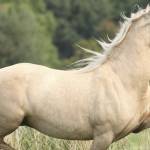How Long Does It Take For A Mare To Dry Up After Weaning
Remember the Mare During Weaning

Maintaining the nutritional well-being of mares and foals throughout weaning is part and package of a successful separation. Weaning will likely be the most stressful outcome of the foal's life, and worse, its chief source of condolement volition have vanished. While concern for the foal is justified, the mare deserves consideration also, and for her the main management chore involves shifting nutritional requirements.
Most mares are fed a concentrate feed while lactating because they require the energy as well as the vitamin and mineral fortification to produce sufficient high-quality milk and to maintain adequate body condition.
Owners should consider tapering off concentrates fed to mares equally weaning day approaches, though concentrate should however be available to the foal. Continue a mare from snatching the foal's feed by using a pitter-patter feeder or by tying the mare while the foal eats.
Kathleen Crandell, Ph.D., an equine nutritionist at Kentucky Equine Inquiry, recommends that all mares, regardless of torso condition, be taken off concentrates during weaning. Because many broodmares are also meaning at this time, they should be kept on an advisable vitamin and mineral supplement, and should still have access to as much good-quality provender as they choose.
"Generally, a one- to two-week break from concentrates will suffice. As before long every bit milk production stops and the udder returns to a normal, nonlactating size, the mare can be started back on concentrates," said Crandell. "As long as the calories and the poly peptide content of the nutrition decrease and there is no suckling stimulus, milk production should stop fairly quickly."
Once the mare has stale up, the focus should turn to weight management of the mare. The demands of lactation affect mares differently. Some mares maintain weight without a problem, while trunk condition seems to cook off others throughout lactation. Those that lose significant amounts of weight during lactation crave the most consideration after weaning.
"If the mare has lost a lot of body condition while nursing a foal, then a high-calorie diet is recommended to help become the mare back to an acceptable weight," said Crandell. The best fashion to add together calories to a diet is through provision of high-quality forage. This may include full-time access to good-quality pasture or generous helpings of a legume hay such every bit alfalfa or perhaps a mixed hay.
Concentrates can be introduced dorsum into the diet gradually. Without the physiological bleed of milk production, the mare should use the dietary free energy to increase body condition. Feeds that are formulated with multiple free energy sources such as starch, fat, and fiber might be useful.
"For the thin mare, it is really of import to get some extra body condition earlier the 3rd trimester of pregnancy to prepare for the high caloric needs of tardily gestation and lactation. Even if the mare is merely a little ribby, information technology would be important to go her to an adequate body condition score (a 5 or 6). She may gain weight quickly once the foal is off her," said Crandell.
Some mares handle lactation with boggling ease from a physiological perspective. If a mare is still at optimal weight after nursing a foal for months, so the principal concern would exist to offer adequate vitamin and mineral intake to residuum the inadequacies of forage. This tin can be washed with a pelleted vitamin and mineral supplement or an equine mineral salt mix or block.
Other Wellness Concerns
Mares typically have few health concerns associated with weaning. Probably the about pervasive is the anxiety associated with separation that normally manifests as whinnying, contend- or stall-walking, and general fretting.
Young mares, particularly showtime-time mothers, seem to become most worked upwards during weaning, while older, wiser mares that accept had numerous foals are typically more stoic. Others seem almost relieved to be finished with their maternal duties.
The modify in feeding coupled with the worry of separation might cause some sensitive mares to feel balmy colic at weaning. Suspected cases of colic should be considered medical emergencies, and a veterinary should be consulted at once.
Though uncommon in mares, another possible health concern is mastitis or inflammation of the mammary organisation.
"Mastitis seems to exist more common at weaning, probably because milk sits in the udder and has a higher take chances of condign infected," according to Bryan Waldridge, D.Five.Chiliad., resident veterinary at Kentucky Equine Research.
"Mastitis is normally caused by a bacterial infection," said Waldridge. "Some people think that insects carry bacteria and play a function in the disease, and that's probably true."
The most obvious clinical signs of mastitis are hurting and swelling. Extreme caution is warranted when examining mares suspected of having mastitis, as many are extremely sensitive and may kick. If you lot doubtable mastitis, consult a veterinarian immediately. Most cases tin can be cleared up with intramammary and systemic antibiotics.
Careful observation of the mare post-obit weaning will help ensure her well-being.
Source: https://ker.com/equinews/remember-mare-during-weaning/
Posted by: smithwiting.blogspot.com

0 Response to "How Long Does It Take For A Mare To Dry Up After Weaning"
Post a Comment